Since the Nepal Mountaineering Association (NMA) was formed in 1978, peak climbing in Nepal has become more popular than ever.
There are now 27 trekking peaks in Nepal.
‘Trekking Peaks’ describe mountain peaks under 7,000 metres in height that can be climbed without any prior rope or crampon climbing experience.
It is for this very reason that the idea of trekking peaks has become so popular, not least because many of the peaks are extremely high!
Generally, you will be given all the instruction you need along your trek. However, the term ‘trekking’ can sometimes be misleading as many of the trekking peaks listed by NMA are extremely difficult and require significant technical climbing skills.
The list of trekking peaks was extended in 2002 and split into NMA-A and NMA-B lists. All trekking peaks and mountains in Nepal over 5,000 metres require a permit to climb.
A few years ago the NMA changed the lists to a total of 27 trekking peaks. The peaks in the list below that are lower than 5,800m can now be climbed with out a permit.
The cost of a permit has now also been standardised. With the exception of Chulu East and Shigu Chuli, all permits cost the following:
- Spring (Mar-May): $250
- Autumn (Sep-Nov): $125
- Winter (Dec-Feb): $70
- Summer (Jun-Aug): $70
You can find out more on costs here.
Nepal Trekking Peaks – Group A
1. Abi (6097m)
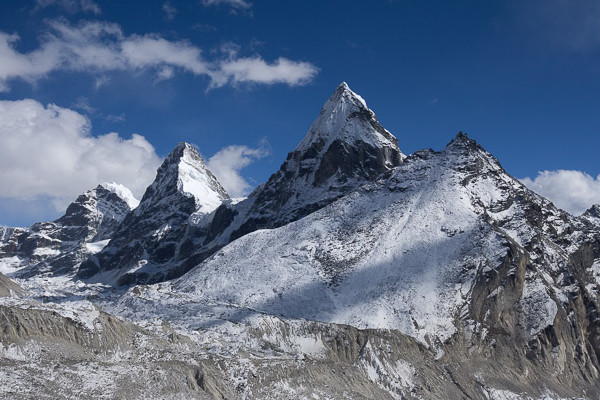
Abi peak actually refers to the twin peaks of Kangchung Shar (6,063 m) and Kangchung Nup – ‘Cholo’ (6,097 m).
Both peaks lie at the northern end of the beautiful Gokyo Valley and both peaks can be climbed under a single permit. While the peaks look spectacular and quite steep, the climbing on their respective ridges is quite straight forward (although obviously steep).
Both peaks are best approached from the south side and your base camp should be made after breaking off from the trekking route to Cho La (5,330 m). It should also be noted that both peaks can also be approached from the north side.
There is more information on both peaks further below.
2. Bokta Peak 6,143m
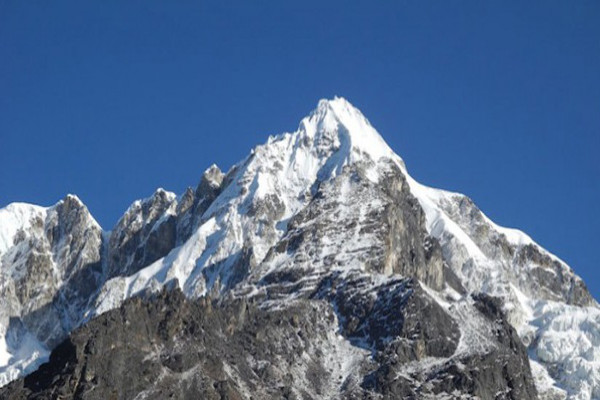
Bokta peak is a fairly intimidating climb in the Kanchenjunga region of Eastern Nepal. The west approach is steep and technical, and the eastern side has no simple route either.
The easiest route is via the col to the north of the mountain. From a high camp at the col, the route follows the snow slope under the right shoulder to the summit. The slope is fairly steep and the route often suffers exposure to rock fall.
This difficult peak can be climbed by serious mountaineers in good weather conditions. The first ascent of Bokta was by a Slovenian team in 1991.
3. Chekigo 6,257m
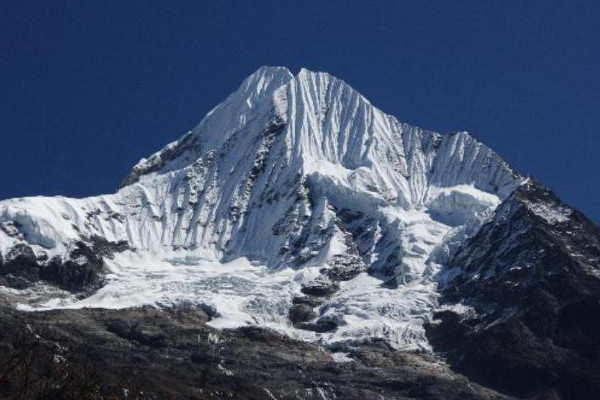
Chekigo is located in the Gaurishankar Himal and the beautiful trek in follows the Great Himalaya Trail. Interestingly, the nearby peak of Gaurishankar (7,134 m) sets the location for the meridian for peculiar Nepal Standard Time, which is 5 hours and 45 minutes ahead of GMT!
Climbing permits were first issued for Chekigo in 2002. However, between 2006 and 2010, the mountain only saw eight small-sized groups attempting the summit.
Set in the wild Rolwaling Valley, it is a peak with great aesthetic appeal, although fairly challenging.
4. Chukhung Ri 5,550m
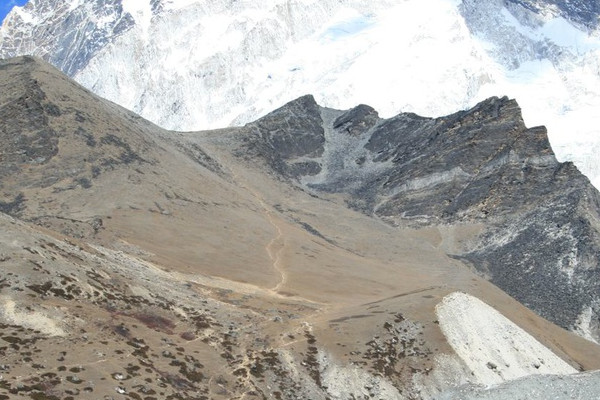
Chukhung Ri is very easy peak, requiring no techincal climbing. In fact, it can be likened to a uphill scrabble than a climb really.
Chukhung lies above the village of Chukhung in the Khumbu Region and is similar to Kala Pattar in the sense that it is more of good view point than a real climb. It takes roughly three to four hours to reach the summit from the village of Chukhung. More often than not, it is often used as an acclimatisation side trip by people going on to climb the more difficult Imja Tse (Island Peak).
The views from the summit of Chukhung are stunning and you can see the peaks of Imja Tse, Ama Dablam, Makalu, and Nuptse from a unique and up-close perspective.
5. Cholatse 6,440m
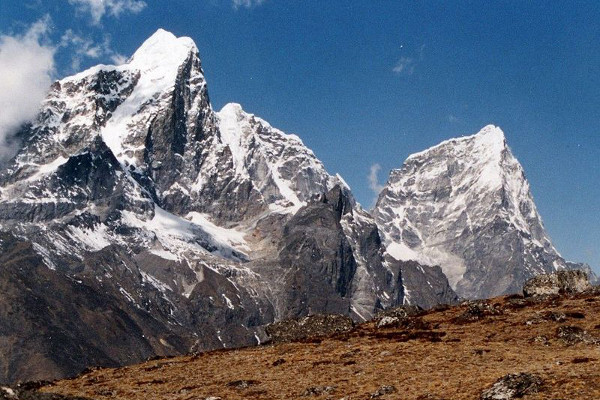
Those who have trekked towards Gokyo from Renjo La, or have climbed to the summit of Gokyo Ri, will remember the stunning view towards Cholatse on the far side of the valley. It’s a beautiful, laid-back-looking peak composed of steep faces with narrow snow and ice ridges.
Unlike many other trekking peaks, all routes to the summit of Cholatse require sustained technical difficulty.
For this reason Cholatse has attracted many of the world’s leading mountaineers to attempt new and highly challenging routes. On April 22nd, 1982, Vern Clevenger, John Roskelley, Galen Rowell and Bill O’Connor reached the summit via the South West Ridge. The South West Ridge is considered the ‘easiest’ route to the summit.
However, the feat was only repeated in 1993, again in 2005 and rarely since then. The South East Ridge was first climbed in 1982 also. The first solo ascent was accomplished on April 15, 2005 by Ueli Steck. Remarkably, Steck reached the summit via a direct line in a 37 hour push from base camp with a night’s bivouac on the face.
6. Kangchung Shar (Pyramid) 6,103m
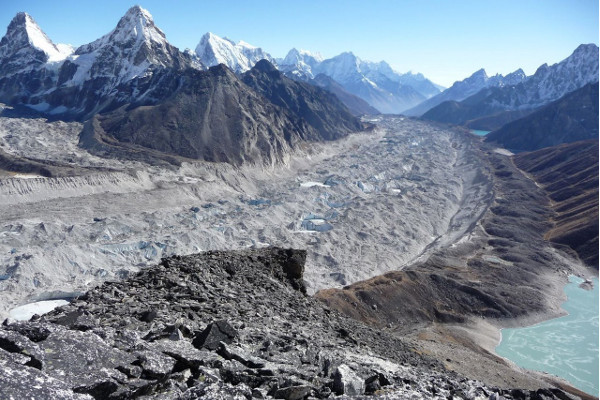
The twin peaks of Kangchung are quite notable from all high points around the Gokyo region, sticking up like islands from the surroundings.
In the Sherpa language, Kangchung means ‘small mountain’. The Schneider map marks a route between the peaks where approaching from the south is fairly straightforward up an icefall.
The north side, however, is impossible, and cannot be passed at all. The eastern Kangchung (Shar) is, if viewed from Knobby View, a steep pyramid and camping on the col will give the best chance of success.
7. Kangchung Nup (Cholo) 6,089m
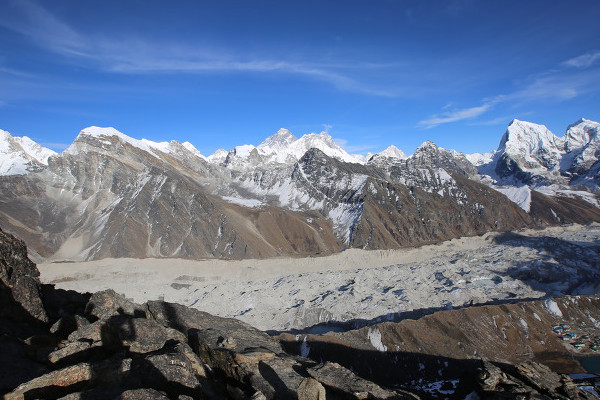
The west (Nup) peak should be attempted from a rock saddle south-west of Surprise Lake. The rock ridge meets a snow gully that requires to 200m of rope to traverse.
This then brings you to the small summit. From here it may be possible to traverse the ridge in good conditions; otherwise drop down the gully (flip your 200m of rope over) and climb down the face, although this isn’t all easy. You would need a 60m climbing rope for the section.
The climb is fairly challenging and the mountain is rarely attempted. It is suitable for mountaineers who have some solid experience and feel comfortable belaying.
8. Kyazo Ri 6,186m
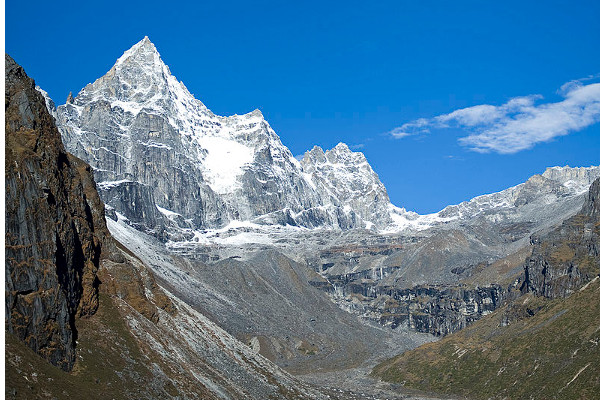
Situated in the Khumbu Himal, Kyazo Ri can be located just north of Namche Bazaar. It is the highest summit in a long line of peaks that separate the Thame Valley to the west from the Gokyo Valley to the east.
The peaks run all the way to Cho Oyu on the Nepal-Tibet border. Although seldom climbed, this is a classic trekking peak with a wonderfully isolated base camp. It’s technically difficult enough to be pleasing for experienced climbers and the summit day’s climbing is often compared to that of Ama Dablam, although at only 6,186 metres, it requires far less acclimatization (and therefore time to complete).
The standard route is south-facing, catching the sun, and encounters few hazards such as rockfalls or avalanches. Basecamp is set in a pristine and gorgeous hidden valley known as the ‘Kyajo Drangka’, which requires a long trek to reach it from Mende – about 4 km from Namche Bazaar.
Reaching Camp 1 from Base Camp is a long slog over rough, but non-technical terrain. Camp 2 is a much shorter distance from Camp 1 but the terrain includes giant boulders and difficult screes. From Camp 2 to the summit is 12 pitches of steep ice and snow, most of which requires belaying, with several steep pitches of up to 65° gradient just before the summit.
9. Langsisa Ri 6,427m
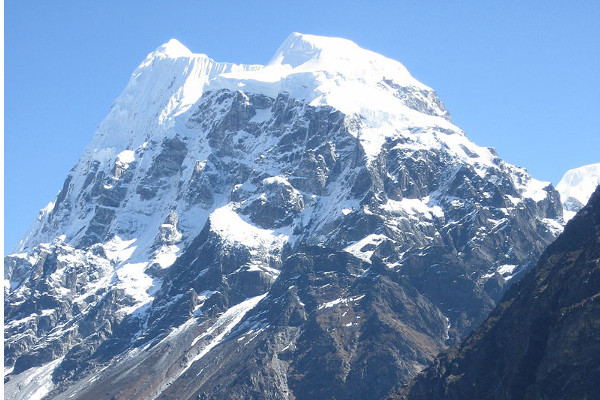
Langsisa Ri used to be a proper expedition peak until the Government of Nepal gave control of the peak to the NMA in 2002. Situated in the popular Langtang trekking region, Langsisa Ri is a technically challenging peak and is perhaps one of the most difficult of all trekking peaks in the region (after Kusum Kanguru).
Langsisa Ri is an ideal choice for those who want a Himalaya expedition-style challenge with a simple and affordable permit system.
10. Larkya Peak 6,010m
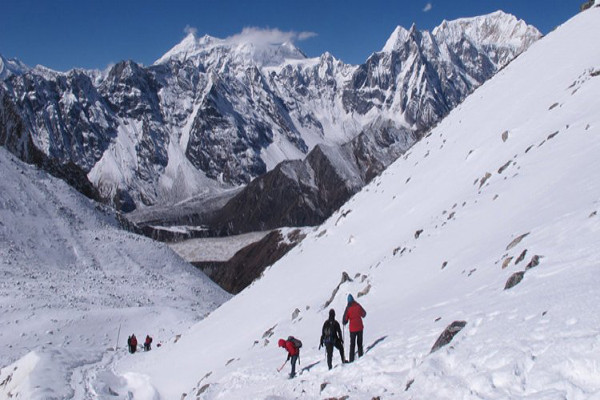
Larkya Peak is a very great peak to climb in combination with the Manaslu Circuit Trek. The climb itself is fairly easy and the summit offers fabulous views of Manaslu, Ganesh Himal, the Annpurnas and beyond. There is often some confusion about which peak Larkya actually is and groups are often lead up a steep route to a subsidiary peak known as Sano (small) Larkya (5,807 m).
Base camp is located close to the Larkya La, a pass of 5,135 m. Sano Larkya Peak can be climbed in one long day from base camp.
However, to climb Thulo (big) Larkya (6,249 m), a higher camp is needed. Reaching the true Larkya Peak is a long but relatively easy climb on snow slopes that are slightly less steep than the slopes on Sano Larkya Peak. The best option for climbers is to make a high camp and then complete both peaks in one day.
11. Lobuje West 6,145m
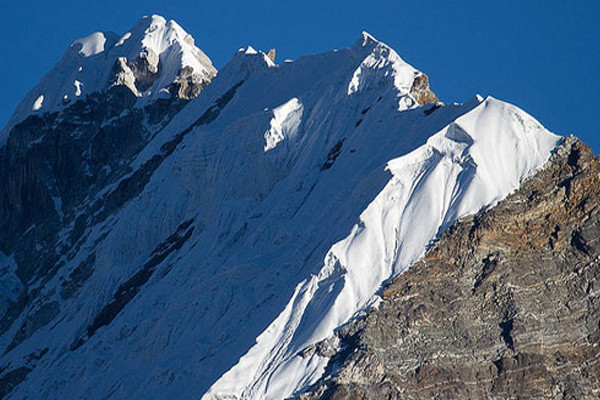
The Lobuje mountain consists of two summits – East and West. A ridge connects them both but there is a sharp drop and a considerably long distance between them making an attempt from the East summit nearly impossible.
Lobuje West was first attempted and successfully climbed in 1955 via the South Shoulder. Since then the mountain has been climbed rarely, perhaps only several times, usually approaching from the east.
12. Machermo 6,273m
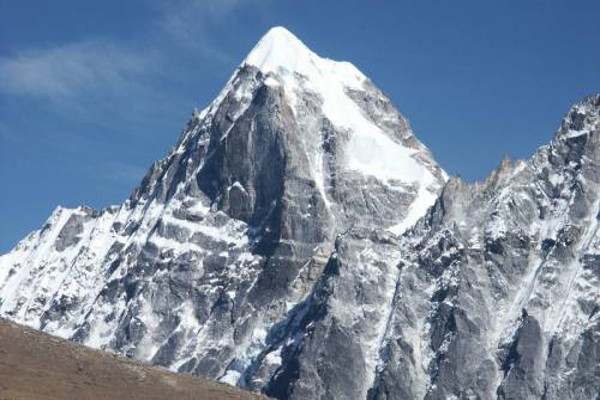
Machermo has a very steep north face on which climbing is fairly challenging and technical. Machermo peak is situated in the Mahalangur region and can be reached on the main trail from Namche Bazaar to Gokyo.
The route to base camp leads through yak pastures and base camp is set up above the rocky meadows and moraine at roughly 5,140 m. Once at the summit you will be rewarded with stunning views of Ama Dablam, Nuptse, Lhotse Shar, Lhotse and Everest.
13. Nirekha 6,159m
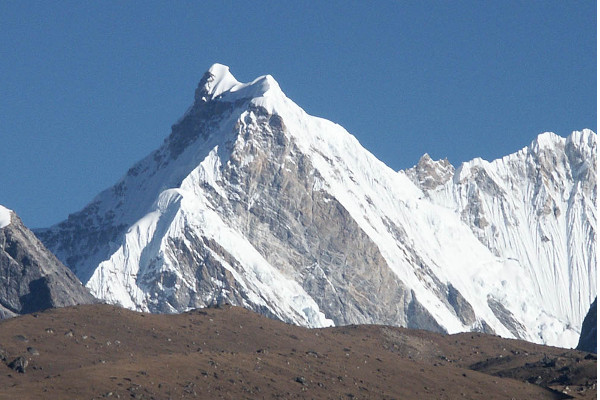
Located in the Khumbu region close to the well-known Cho La crossing between Gokyo and Lobuche, Nirekha peak lies just west of Lobuche West. This is a great route for an experienced alpine climber.
The ascent is mostly on ice and snow but demands a high level of fitness and acclimatization as most of the difficult climbing is above 5,800 m. Although the peak can be reached via the valley above Dragnag on the route to the Cho La pass, it is much easier and safer to begin at Kanchung Base Camp (5,250 m) near the Gaunara Glacier.
The summit can be reached in nine hours from there in good weather conditions.
14. Ombigaichen 6,340m
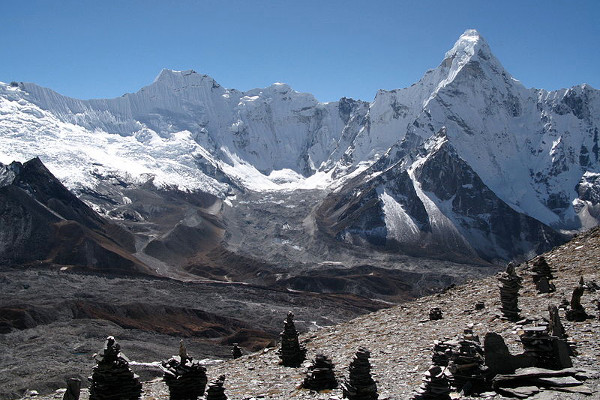
Ombigaichen is a very striking mountain located 2.3 kilometers south-east of Ama Dablam on the long ridge that connects Baruntse with Ama Dablam.
It is the one peak that all Ama Dablam climbers say they would love to climb one day. Even so, it is seldom climbed. Only four expeditions were attempted from 2006 to 2010 and only two of these were successful.
Ombigaichen was first climbed by an expedition lead by the famous Sir Edmund Hillary, with James Milledge (UK) and Ang Tshering Sherpa reaching the summit on 18th of November 1960 via the North-West Ridge.
A British expedition led by Victor Saunders, reached the summit via the South Ridge on 3rd December 2002.
15. Yala Peak 5,732m
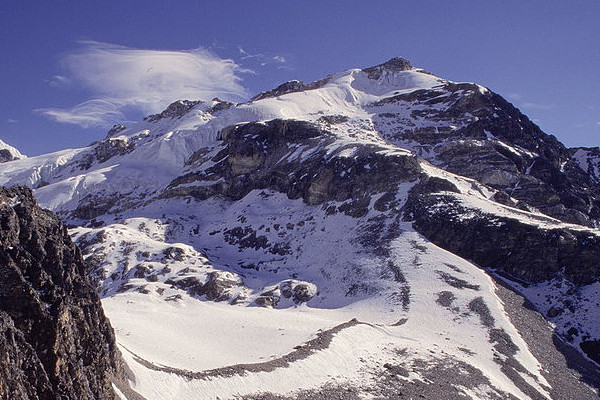
Yala Peak lies close to the Tibetan border, north-east of Kyangin Gompa (3,870 m) in the Langtang Valley region. Yala Peak is usually climbed in two days from Kyanjin Gompa with a high camp being laid at Yala Kharka (4,900 m). It is also possible to summit Yala Peak in a single long day with a pre-dawn start.
Yala is one of the easiest trekking peaks in Nepal to scale and is often climbed as preparation for Ganja La Chuli (5,844 m). The summit of Yala is renowned for providing a stunning view.
If you want the feeling of being right up in the Himalayas, with few other people around, and without any technical climbing difficulty, Yala Peak is a great choice.
16. Yubra Himal 6,035m
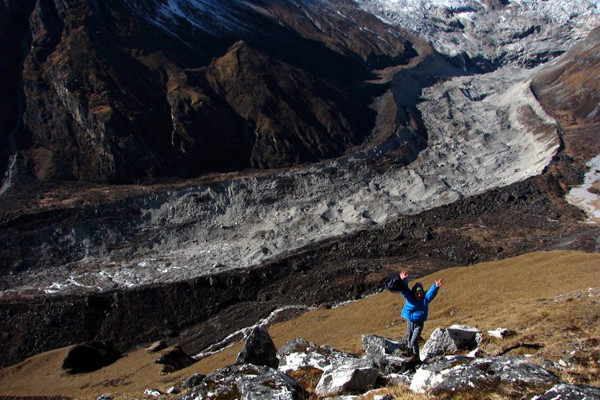
The fin-like ridge of Yubra is only just visible over the Lirung Glacier from the view point at Kyanjin Gompa. Take the short trek up to Kyanjin Ri (4,773 m) however, and the view of the route to the summit opens up. From Kyanjin Gompa the route follows the right side of Lirung Glacier to reach the end of Yubra Glacier.
To avoid the ice, the route follows a fairly steep gully far to the left which requires some scrambling to climb. The glacier then flattens out in a cwm which can then be crossed to make high camp. You can then join the ridge from the northern most edge at the head of the glacier. A 2am start should bring you to the summit around 9am.
Fixed ropes can be necessary on some sections of the ridge. The views from the summit are stunning and look out towards the surrounding peaks, Ganesh Himal and into Tibet. Despite its stunning location and technical appeal, it’s a peak that is seldom climbed.
Peak Climbing in Nepal – Group B
17. Chulu East 6,200m
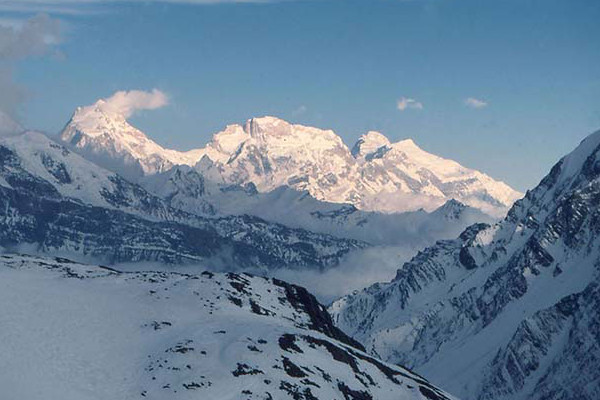
The trekking peak Chulu East is often combined with the classic Annapurna Circuit Trek. You approach base camp from the village of Manang.
The most commonly used route to the summit is via the North-East Ridge which was first climbed in 1955 by a German expedition. Situated high above the Manang valley, Chulu East has breathtaking views across to the Annapurnas II, III and IV, Gangapurna, Tilicho Peak, Dhaulagiri, Glacier Dome, and Manaslu.
Chulu East requires previous alpine experience as there are frequent crossings of fractured glacial terrain and steep section scree slopes to reach the main high summit ridge.
18. Chulu West 6,419m
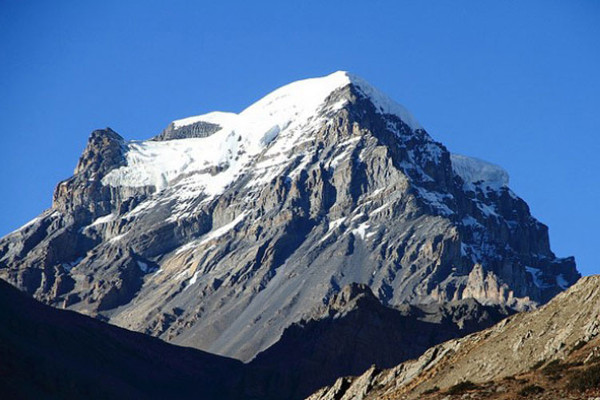
If Chulu East is considered the Island Peak of the Annapurnas, then Chulu West should be the Mera Peak alternative. No real technical climbing experience is needed and it is not particularly difficulty to reach the summit but progress can sometimes be slow depending on weather and snow conditions.
Above base camp steep loose rock often requires some fixing of ropes. The peak was first ascended in 1952 by a Japanese Expedition.
19. Huin Chuli 6,441m
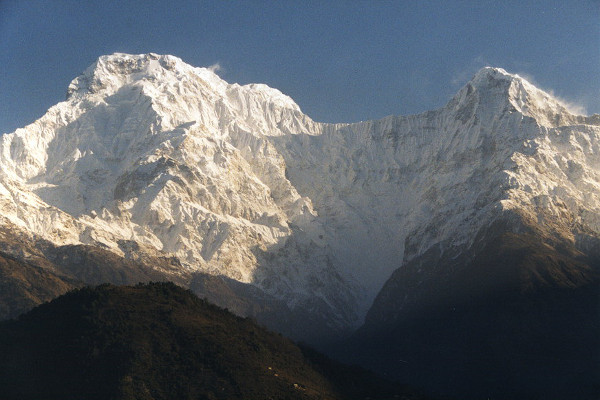
Huin chuli forms an emposing south-facing wall together with Annapurna South. Sadly, it has a reputation for being prone to avalanches, rock fall and route finding problems.
There is no ‘standard’ route up and the peak is therefore best tackled in true expedition style. Even though it offers virgin route potential, it has received very little attention from climbers over the years.
The most common approaches are via the Northwest Face or the Southeast, although the latter is more popular. An American Peace Corps Expedition first climbed the mountain in October 1971 via the Southeast Face.
20. Island Peak (Imja Tse) 6,173m
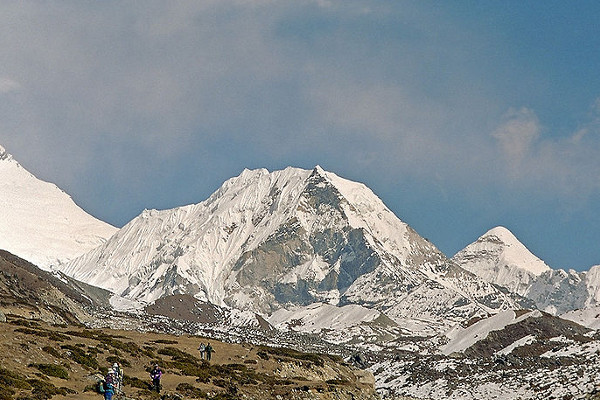
Imja Tse, or as it is more popularly known ‘Island Peak‘, is one of the most popular trekking peaks in Nepal. Originally named by Eric Shipton who thought the peak looked like ‘an island in a sea of ice’, the mountain was later renamed as Imja Tse in 1983. Island peak was first climbed in 1953 by a British team in preparation for their Everest attempt.
Tenzing Norgay was one of the members of that successful climb. Between 2006 and 2010 over 12,000 people have attempted the summit.
Despite its popularity though, it is still a fairly tough climb and many climbers fail to reach the summit. The main reason is often insufficient acclimatization, and sometimes because of deep snow or bad weather conditions. The peak makes up part of the south ridge of Lhotse Shar and the gigantic summits of Lhotse, Nuptse, Middle Peak and Lhotse Shar rise high above the summit to the north.
To the east of the peak lies the looming west face of Makalu and the famous form of Ama Dablam can also be seen to the south-west.
21. Kongma Tse 5,817m
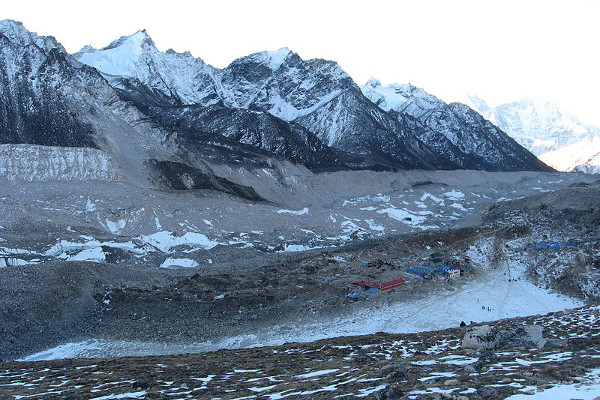
Kongma Tse rises to the north of Kongma La and stands high above the Khumbu Glacier opposite the small village of Lobuche. It is one of several peaks that make up the long south-west ridge of Nuptse between the Nuptse and Khumbu Glaciers.
Seen from Gorak Shep, the summit has a lovely diamond shaped hanging glacier above a steep rock wall that makes up the mountain’s North Face. From Bibre, near Dingboche, the mountain is much more accessible.
22. Kusum Kangguru 6,369m
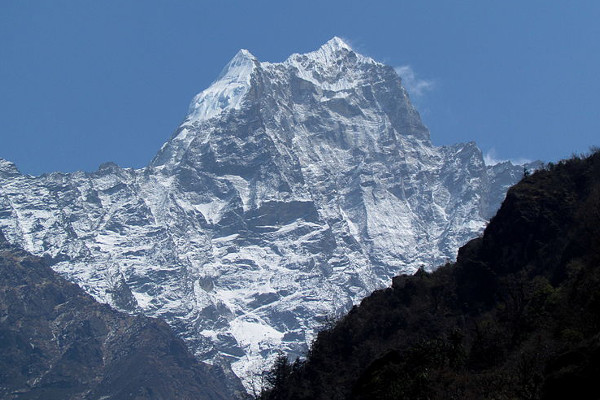
The name Kusum Kangru comes from Tibetan meaning “Three Snow-White Gods”. At 6,369 metres, Kusum Kangru dominates the south end of Charpati Himal and separates the churning Dudh Koshi valleys from the upper reaches of Hinku Drangka. The mountain is quite complex having at least five major ridges and faces. The most spectacular face is the North face of the main summit.
This is one of the most difficult trekking peaks in Nepal to climb. The first successful ascent was made by Bill Denz (New Zealand) on 7th October 1981 via the South-West buttress.
On top of this, Denz also completed the first solo climb and traverse of the mountain, descending via the northwest flank of the mountain. In subsequent years new routes have been opened, however, all of them are technically very demanding.
23. Kwangde 6,187m
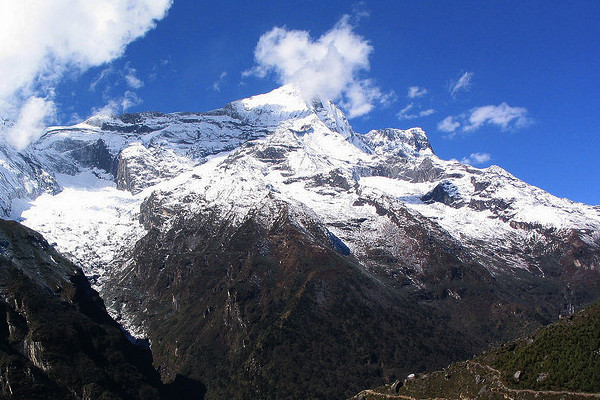
Kwangde Ri is a very impressive ridge of summits to the south-west of Namche Bazaar. Stunning waterfalls cascade down from the mountain’s lower gullies which hikers often gaze at through tea-house windows in the town of Namche.
Kwangde Ri is the collective name for the line of peaks running west to east that includes Nup (6,035 m), Kwangde Shar (6,011 m), Kwangde Lho (6,187 m), rocky Nupla (5,885 m). All of the peaks are covered by the one peak permit.
There are many routes up the various peaks and all have differing technical difficulties, especially from the steeper northern side. Kwangde Lho, the tallest of the peaks was famously climbed by Jeff Lowe and David Breashears in 1982 via an extremely steep and difficult ice and rock line. Less steep routes can be found on the easier southern side which can be reached via the secluded Lumding Valley. Kwangde Lho was first climbed via the South Ridge in 1975, and Kwangde Shar in 1972 via the South Face.
24. Lobuche East 6,105m
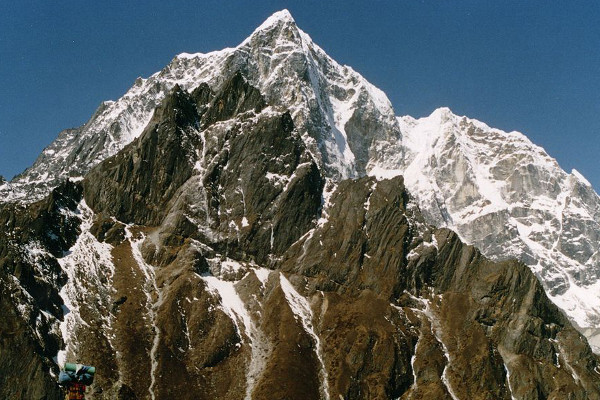
Many aspiring Everest teams climb Lobuje for acclimatisation practise as the summit is the same altitude as Camp 1 on Everest and it saves making at least one dangerous trip through the infamous Khumbu Icefall. The South East Ridge is the most popular, graded as PD+ on the Alpine Grading system.
Generally, teams only climb to a false summit on the summit ridge. To reach the summit proper, it becomes progressively narrower and more difficult. The views from either are spectacular. From high camp the route continues up through a series of rocky slabs that become ever steepers to give access to the South-East Ridge proper. About 50 metres from the main ridge the slabs end and there is a 45-50 degree snow slope to ascend onto the ridge itself.
The start of the ridge is roughly at 5,670 metres and this is also a good site for a second high camp if you wish to make the summit day easier. Ascend the ridge turning around seracs towards the first summit. There are no real climbing difficulties although there is a feeling of some exposure along the ridge.
Between the first/false summit and the true summit there is a considerable downwards slope which you may want to rappel down before the final 60 metres or so. Laurence Nielson and Ang Gyalzen Sherpa made the first recorded ascent of Lobuje East on 25 April 1984.
25. Mardi Himal 5,587m
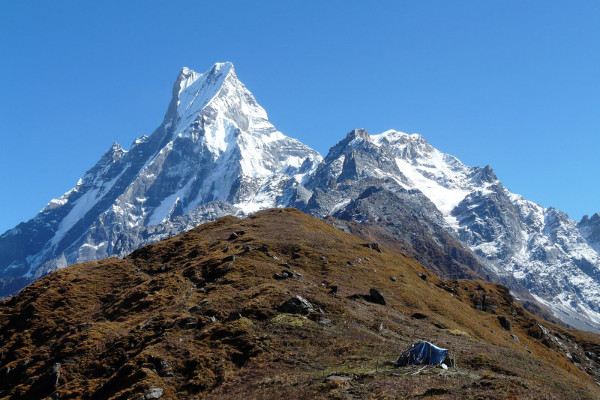
Locarted less than 20 km from Pokhara, Mardi Himal is the most southerly peak of the Annapurna range. first ascended in 1961 via the East Flank, this is still only route used so far. The peak is a continuation of the southwest ridge of Machhapuchhare and is best viewed from the south.
The south-west face of the mountain has three well defined ridges rising out from rock buttresses and separated by hanging glaciers. The east face is separated from the Machhapuchhare ridge by a col at roughly 5,200 meters. The standard climbing route passes through this col.
The summit offers a gorgeous view of the Annapurna Range and the sacred Machhapuchhare, more commonly known as ‘Fishtail’. The valleys and ridges south of Mardi Himal are steep and heavily wooded with lovely bamboo and rhododendron trees.
26. Mera Peak 6,476m
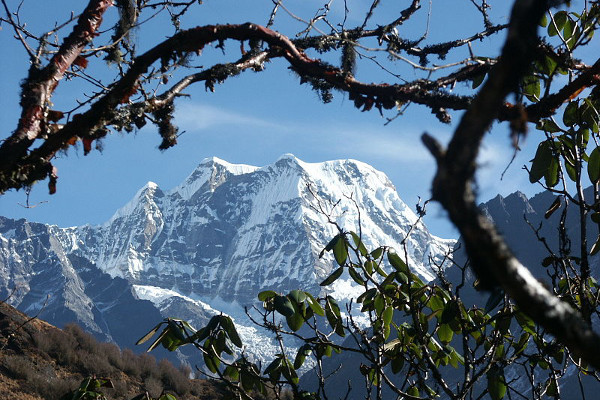
Standing prominently between the wilderness valleys of Hinku and Hongu, Mera Peak lies to the south of Everest and to the north-east of Lukla. Second in popularity only to Island Peak, Mera peak sees roughly 2,000 people attempt its slopes every year.
Its popularity stems from the fact that five of the world’s 14, 8,000 metre peaks are visible from the summit. Climbing to the summit of Mera from base camp is considered hardly more than a mountain walk across a crevassed glacier. However, its high altitude must be respected and acclimatisation must be completed at the recommended pace. This usually means reaching the summit 12 days after arriving at Lukla.
Many people fail to reach the summit because of they fail to acclimatize properly – there is no shortcut way to climb a mountain of this height.
Mera has two summits. The easier summit attempted by most groups is accessed by taking a higher line up to the eastern summit with a steep last 20 metres or so. The true summit can be reached by either a drop and traverse (technically beyond many people by this stage) or by initially taking a more westerly lower route out of the high camp for a steep section to the true summit.
Sen Tenzing and Jimmy Roberts managed the first successful ascent of Mera on 20 May 1953. The route the two men used is still the standard route.
27. Naya Kanga 5,846m
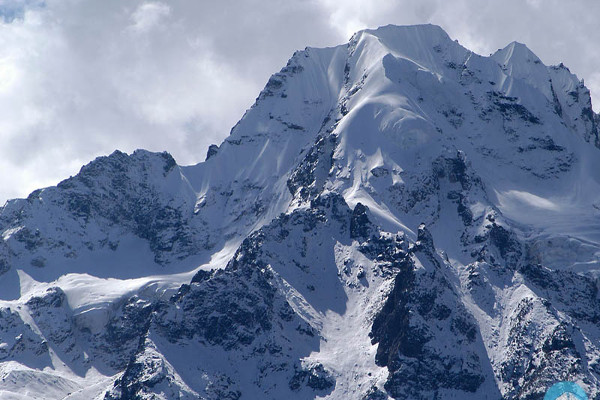
Naya Kanga is the beautiful looking peak to the south of Kyanjin Gompa, the destination village for the popular Langtang Trek in the Langtang National Park.
The standard route to the summit is via the snowy north-east ridge. Most of the climb is fairly straightforward, however, there is one steep section on 40 – 55 degree snow where belaying is necessary. The peak is approached on the trail across the Ganja La, the difficult but direct pass from Langtang to Helambu.
The climb is usually incorporated into a crossing of the pass and is often done with two camps. The first is Ganja La base camp (some 500 meters above Kyanjin Gompa) and the second a high camp at around 4,900 meters. The summit offers incredible views of the peaks lying along the Langtang Valley.
28. Paldor 5,928m
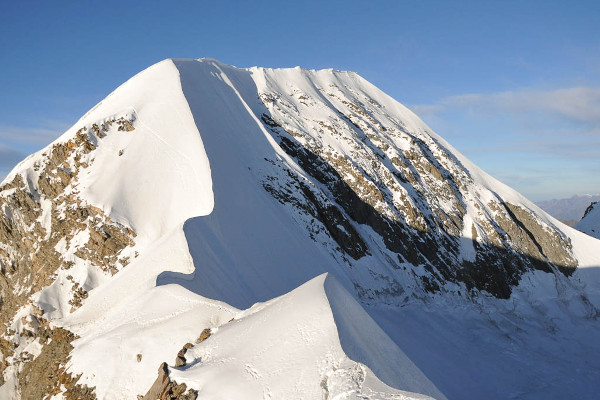
When the weather is clear, the Ganesh Himal range can be seen a spectacular backdrop to the north-west of Kathmandu, with the icy peaks of Ganesh I (7,406 m), Pabil (7,101 m), Ganesh V (6,950 m) and Logsang Karpo (7,150 m) looming just above the forested valley rim.
Paldor lies at the south-east end of this range at the intersection of the Tiru and Karpu Dandas ridges. While it is under 6,000m, it provides a satisfying and reltively difficult climb. The main route across the glacier is crevassed and takes some locating.
When you reach the col there are two options. Either climb the straightforward ridge using ropes, or continue on around to the crevassed back for an easier 45 degree ridge.
In good conditions making a traverse of the mountain is quite possible. From the summit there are tremendous views of the Ganesh Himal peaks, Langtang Lirung (7,227 m) and Manaslu (8,156 m). The peak was first climbed by Peter Lloyd, Bill Tilman, Tenzing Sherpa and Da Namgyal in the wet season of 1949 via the North-East Ridge.
29. Pharcharmo 6,273m
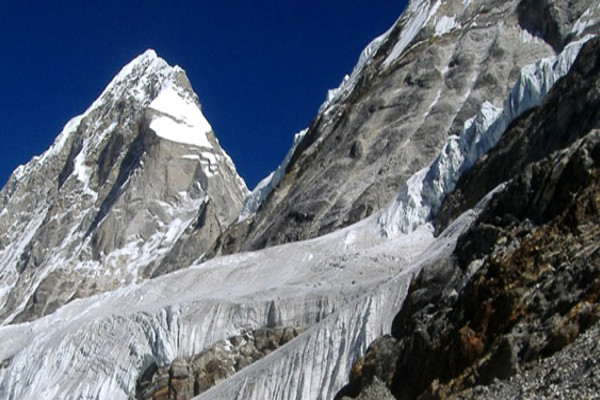
First climbed in 1955, Pharchamo Peak is a beautiful snow peak located to the south of the formidable glaciated Tashi Lapcha pass (5,760 m) which connects the Thame and Khumbu Valleys with the Rolwaling Valley. It has a north-by-northwest ridge, which rises from the crevassed glacier above the Tashi Lapcha.
The face of the ridge forms a uniform slope broken by seracs and crevasse. The lower reaches are not difficulty, however, towards the summit, depending on seasonal conditions, open crevasses and ice-steps often present some challenges.
30. Pisang Peak 6,091m
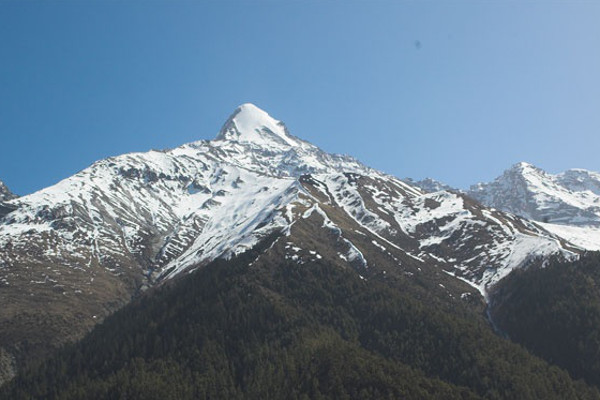
Pisang peak lies slightly north of the Manang Valley which the notable Annapurna Circuit passes through. While the climb is sometimes offered as a three day trip from the village of Pisang, this is only possible if you’re already properly acclimatised. Since 2005, the climb approaches via the West ridge.
The upper part of the ridge, above the high camp at 5,200 metres, is guarded by enormous rock slabs which make it very difficult to climb, especially in bad weather conditions. This peak is generally better for climbers with some solid experience.
There are, of course, stupendous views to be seen from the summit over the Manang Valley and also the Annapurna Range. A German expedition made the first successful climb of Pisang Peak in 1955.
31. Pokalde 5,794m
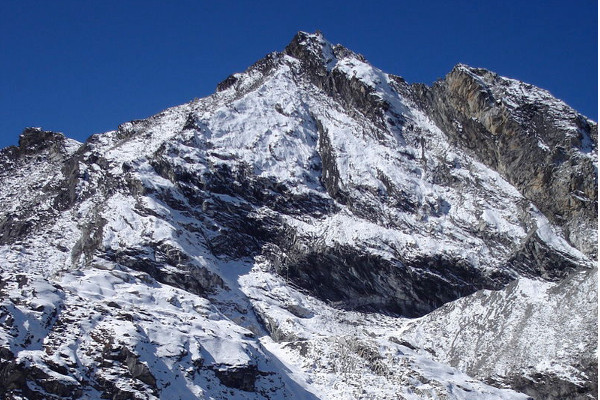
Pokalde can be first seen on the trail between Pangboche and Pheriche. The peak from there looks like an undulating rocky ridge dwarfed by the huge bulk of Nuptse standing directly behind it. There are various approache routes, but most people tend to climb the North Ridge from the Kongma La (5,535 m).
The ridge is generally a rocky scramble that requires rope protection towards the summit as the ridge steepens, however, the climb rarely requires ice-axe or crampons except in the winter season.
The summit has an excellent viewpoint with views stretching over to Makalu, Ama Dablam and Pumori. Sadly, Everest is obscured from view by the ridge of Lhotse. Pokhalde was first climbed in 1953 via the Kongma La route along its northern ridge by the 1953 Everest Expedition team led by John Hunt.
32. Ramdung 5,930m
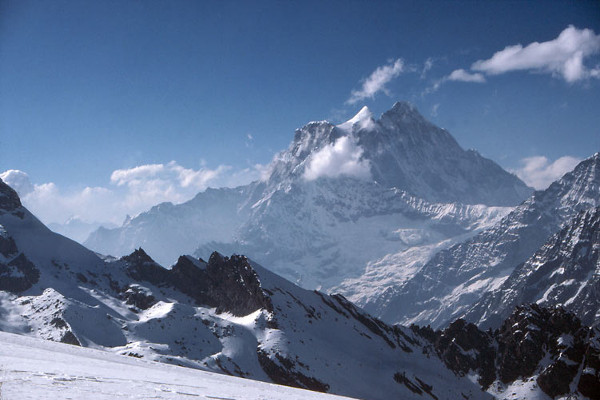
Ramdung is situated in the remote and wild upper Rolwaling Valley due south of the village of Na. It is usually climbed in combination with Parchermo (6,187 m) and also a crossing into the Khumbu via the infamous Tashi Lapcha pass (5,760m).
The trek into Rolwaling adds to the attraction. It is far less busy than the Khumbu region and is a secretive and beautiful valley which twists and turns, with views restricted by steep cliffs of forested rhododendrons, until the valley widens out into superb Himalayan mountain scenery.
The standard route up the North-East Face of the icy dome of Ramdung is long and normally requires two camps for proper acclimatisation. Base camp is usually located below the Yalung La (5,310 m), and nearby Yalung Peak (5,650 m) is an ideal acclimatisation climb.
The gorgeous high camp is normally situated on the glacier below the summit ridge. The mountain offers a stunning panoramic view of mountain ranges from Langtang to Everest and a gorgeous view of the mighty triple topped peak Gauri Shankar and Menlungtse.
33. Singu Chuli (Fluted Peak) 6,501m
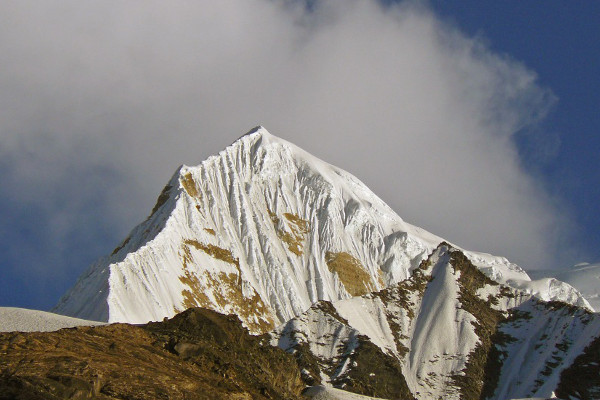
Shingu Chuli is a striking mountain that stands dead in the centre of the Annapurna Sanctuary separating the West and South Annapurna Glaciers. While many climbing teams head to its much easier neighbour Tharpu Chuli (Tent Peak), Shigu Chuli remains a challenge reserved only for experienced climbers.
The first ascent was made by Wilf Noyce and David Cox on its North-East Face and the top section of the East Ridge in 1957 and gave it the name Fluted Peak. Various routes are possible but the South Ridge is the most usual and attractive line.
Shigu Chuli makes for lovely, easy to access, low-cost Himalayan climbing in the centre of the inspiringly beautiful natural amphitheatre of the Annapurna Sanctuary.
34. Tharpu Chuli (Tent Peak) 5,663m
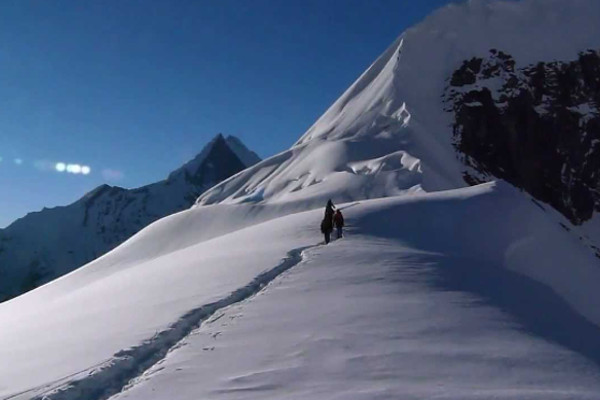
Also known as Tent Peak, Tharpu Chuli offers a challenging but very achievable two week expedition in the heart of the Annapurna Sanctuary.
Of the the three Sanctuary peaks Tharpu Chuli is the most popular (the others being Hiunchuli and Shigu Chuli). Its lower altitude keeps itineraries fairly short, the climbing is reasonably straightforward and the peak enjoys a fabulous location, right in the centre of the Annapurna Sanctuary, giving a stunning panoramic view from its summit.
The expedition begins with a picturesque tea-house trek, through lovely villages and rhododendron forests, into the amazing high amphitheatre of the Annapurna Sanctuary. Usually a high camp is placed below the mountain’s north-west ridge, a steep climb leads to the easy summit ridge with its uninterupted views to Annapurna South, Fang, Annapurna I and the glorious Machhapuchhre (Fish Tail).
Trekking Peaks in Nepal (Top Tips)
Safety
Trekking peaks should not be taken lightly and the need for an experienced guide is essential. When booking a guided trek please make sure your guide has at least a NMA Advanced course qualification. This is the minimum qualification you should accept, better would be a guide with a UIAGM/IFMGA qualification. A proper guide will provide ropes no matter the trekking peak, in case of crevasses and steep slopes. Make sure your guide is properly insured and that you also have trekking insurance for Nepal.
If you plan on trekking a peak alone then please be fully aware of your own limits and take great caution as these peaks are not to be taken lightly. Although the trekking routes mentioned below are fairly basic for a high level climber, one should always be fully prepared in the Himalaya, especially as bad weather can set in extremely rapidly.
Acclimatization
Acclimatization is extremely important when trekking in Nepal and, sadly, something that is often overlooked by many visitors. Even when ascending slowly, the height of many peaks is still a shock to the system. Try not to climb more than 300-400 metres per day. Drink plenty of water and give your body enough rest time.
For a detailed article on altitude sickness and acclimatisation see here.
FAQs
That’s it folks, we hope this article has been of some use to you in deciding which peak to trek in Nepal! If you have any further queries or would simply like to know a little more about one of the peaks, please leave a note in the section below and we’ll get back to you within 24 hours.
If you want to read more about the most famous of all peaks in Nepal, check out this article of fun facts about Mount Everest.
Tags: Peak climbing in Nepal, Nepal trekking peaks, Trekking peaks, Trekking peaks in Nepal

This information was brilliant many years ago. I still greatly appreciate it, but all the information on fees is outdated. Check the Nepal Mountaineering Association website.
https://nepalmountaineering.org/service-charges-for-foreign-climber-per-person-in-us-dollar
There are now only 27 Trekking Peaks. The peaks listed on this page below 5,800 meters can now be climbed without any fee at all.
The method of charging fees has changed too. It's now per-person, and at lower rates for a single climber. With two exceptions, all peaks are charged the same. $250 in the spring, $125 in the fall.
Thanks for your thoughtful research many years ago, and your clear writing!
Hi Gary, thanks for the heads up. We will update the article to reflect these changes.
One of the best post regarding beginner peaks in Nepal I came through, glad to be here.
So, this is one of best listing peaks from Nepal. And, i hope this blog brings many of adventurous people to Nepal for climbing peaks in Nepal. After pandemic covid-19, it helps again surely to promote Nepalese tourism around the globe…
I love the witty presentation ? It truly baffles me how many people fail to consider their level of fitness before embarking on treks while traveling, or any of these other factors! The couple of girls who wore Converse sneaker one of them slipped and twisted her ankle before we’d even gotten halfway to Chulu east peak.